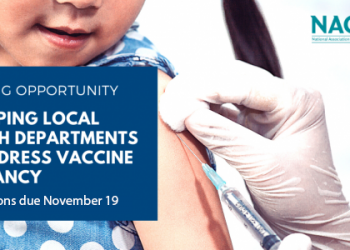In the October 15th Morbidity and Mortality Weekly Report (MMWR), the Centers for Disease Control and Prevention (CDC) released the results of the 2020 National Immunization Survey-Child (NIS-Child), Vaccination Coverage by Age 24 Months Among Children Born in 2017 and 2018 -- National Immunization Survey - Child, United States, 2018-2020. The NIS-Child monitors coverage with vaccines recommended by the Advisory Committee on Immunization Practices for children during the first 24 months of life to prevent 14 diseases.
Key findings are listed below, including some that have particular implications for public health practitioners. Persistent disparities in vaccination coverage by health insurance status, race and ethnicity, and poverty status indicate that improvement is needed to achieve equity in the national childhood vaccination program. Additionally, coverage with most childhood vaccines among children born in 2017 and 2018 was lower among those who were uninsured, Black, Hispanic, or living below the federal poverty level than it was among those who were privately insured, White, or living at or above the poverty level indicating these populations should be given special consideration while on-going disruptions in service caused by the COVID-19 pandemic continue.
Key findings
- National coverage by age 24 months remained stable and high, with over 90% getting the recommended vaccines that prevent measles, mumps, and rubella (MMR), polio, hepatitis B, and varicella.
- Estimates reflect vaccination opportunities that mostly occurred before disruptions from the COVID-19 pandemic.
- Only 1.0% of children had received no vaccinations by age 24 months, a decrease from 1.4%.
- CDC’s analysis found barriers to health care access associated with health insurance status and poverty level may keep some parents from getting their children vaccinated.
- Coverage with most vaccines was lower among children who were not privately insured.
- More uninsured children (3.3%) received no vaccinations by age 24 months than privately insured children (0.8%).
- Coverage with most vaccines was lower among children living below the poverty level than those living at or above the poverty level.
- Disparities in coverage were also observed by race/ethnicity.
- Coverage was lower for Black and Hispanic children compared with White children for most vaccines.
- Considering the disruptions to healthcare provider operations caused by the COVID-19 pandemic, extra effort will be required to achieve and maintain high levels and equitable coverage with routine childhood vaccinations.
- Health systems and providers can:
- Send reminders to families whose children are behind on visits to help improve vaccination coverage.
- Offer vaccination-only appointments or hold vaccination clinics.
- Implement systems to review vaccine history at every visit.
- Flag medical records when a child is behind or due for vaccination.
- Offer strong recommendations and have standing orders.
- Use CDC’s Vaccinate with Confidence strategies and resources to reassure vaccine hesitant families.
- Health systems and providers can:
Efforts by healthcare providers and parents are needed to ensure that all children are protected from vaccine-preventable diseases, and parents and providers should use any visit as an opportunity for the child to get recommended vaccinations that are due or might have been missed because of COVID-related disruptions. CDC and the American Academy of Pediatrics (AAP) recommend every child continues to receive recommended vaccinations during the COVID-19 pandemic.
Let’s Play Catch-Up Campaign
Families have been doing their part by staying at home as much as possible to help stop the spread of COVID-19. An unfortunate result is that many children missed check-ups and recommended childhood vaccinations. As children return to in-person learning and care, it’s particularly important for parents to work with their child’s doctor or nurse to make sure they get caught up on missed well-child visits and recommended vaccines. To address the drop in childhood vaccine orders that resulted from COVID-19 disruptions, CDC has launched the “Let’s Play Catch-Up on Routine Vaccines” Campaign to support messaging, resources and guidance encouraging routine well-child visits and recommended vaccinations for children during the on-going pandemic.
CDC aims for these materials to be used to reach parents of children who are younger than six years of age, including those who are uninsured and underinsured, with a variety of materials disseminated through a multi-channel approach. Local health departments and providers are encouraged to use these new materials to communicate with parents the importance of catching their children up on routine vaccinations and well-child visits. Materials are available in both English and Spanish and include a web feature, sample social media content, a newsletter template, and an infographic.
- Resources for public health partners: Resources to Encourage Routine Childhood Vaccinations | CDC
- Resources for parents: Well-Child Visits and Recommended Vaccinations | CDC



